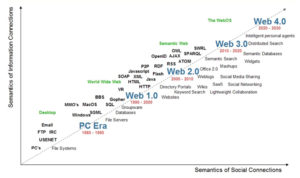Education 1.0 > 2.0 > 3.0 > 4.0
Educación 1.0
Education 1.0 can be compared to Web 1.0 as there is an unidirectional dissemination of knowledge from the teacher to the student. A behaviour based on the three R’s – receiving by listening to the teacher; responding while taking notes, studying text, spreadsheets and doing; and regurgitating when doing the standardized tests. Students are seen as receptors of that knowledge and as such, they do not have unique characteristics. All are seen as one. It is a standard / one unique form for all education.
Educación 2.0
As in web 2.0, Education 2.0 includes a greater interaction between the teacher and the student; one student to another; student to content / expert. Education 2.0, like Web 2.0, allows interaction between content and users, and between users themselves. Education 2.0 has progressive roots where the human element is important for learning. Teacher-to-student and student-student relationships are considered as part of the learning process. It focuses on the three C’s – communicating, contributing and collaborating.
Educación 3.0
Education 3.0 is based on the belief that content is freely and easily available as shows the characteristic of Web 3.0. It is self-directed, interest-based learning, problem solving, innovation and creativity are the engine of education. Education 3.0 also contains the three C’s, but a different set – connectors, creators, constructivists. These are qualitatively different from the three C’s in Education 2.0. Those three words reflect the art of being a self-directed student instead of learning the facilitated by the educator.
Educación 4.0
Education 4.0 is based on the availability of the content. Everything the student needs is offered when needed. For that it is necessary to have a collection of educational materials ready to be provided to the students. They cover all their needs, whatever they may be. A correct granularity of the different learning objects is fundamental to be able to give the system a dynamism that can be adapted to the student’s need in each moment. As it is not only self-directed, but also personalized, it integrates with other materials and students. That allows cooperation and collaboration and enables independent models of learning where the teacher is limited to be a mere tutor in the student’s learning. This does not mean only uploading some videos to Youtube and some pdf’s. It means the creation of a dynamic learning system that continually interacts with the student and modifies the contents offered according to their specific needs at a given time, and which in turn does so by integrating the student with a heterogeneous group of students where, although everyone has their specific and specific needs, they converge on specific points to carry out common tasks.
- https://thepaisano.wordpress.com/tag/semantic-web/

